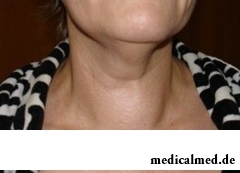





Nodal craw

Craw is called the enlargement of the thyroid gland. In that case when in a thyroid gland there are nodal educations, speak about a nodal craw. The nodal craw – the most frequent pathology of a thyroid gland, occurs at 5% of the population, and by estimates of specialists if to consider the latent forms of a nodal craw revealed sometimes is accidental during inspection in other occasion, this figure can safely be doubled. Women are subject to a nodal craw four times bigger, than men.
The nodal craw is a group of the diseases combined by the general sign – existence of nodes in a thyroid gland. The matter is that tissue of a thyroid gland is formed by a set of follicles, each follicle represents the microscopic cellular sphere containing inside substance in a colloid form. The thyroid nodule represents the increased follicle – single, multiple (a multinodal craw), several increased follicles soldered among themselves, the follicular cyst or a tumor which arose from a follicle (adenoma including malignant).
Reasons of a nodal craw
Reasons of a nodal craw still neustanovlenna. It is considered to be that residence in areas with the reduced content of iodine in water (a local craw) matters, however data of medical statistics say that nodes in a thyroid gland are formed at the people living in areas with the normal content of iodine is not much more rare. Therefore if low content of iodine not the only reason of a nodal craw.
Increase in follicles and formation of cysts happens in response to changes in an organism at which load of a thyroid gland raises. It happens at various diseases, genetic predisposition, and also influence of some factors of the environment, especially stresses. Some specialists consider such forms as a colloid proliferating nodal craw, age change of a thyroid gland.
Types of a nodal craw
Depending on an origin, structure and the reason of a nodal craw, distinguish its following types:
- Local nodal craw;
- Solitary node (single thyroid nodule);
- Multinodal craw (set of thyroid nodules);
- Kongolomeratny nodal craw (a conglomerate from the nodes soldered among themselves);
- Diffusion and nodal craw (nodes are educated in the increased thyroid gland);
- True cyst of a thyroid gland;
- Follicular adenoma of a thyroid gland (benign tumor);
- Malignant tumor of a thyroid gland.
Degrees of a nodal craw
Depending on that, the thyroid gland is how increased, define degrees of a nodal craw. Earlier classification of degrees of a nodal craw by O. V. Nikolaev was accepted, in 1994 the World Health Organization offered new classification. However in clinical practice both Nikolaev's classification, and the WHO classification therefore we will bring both is applied now.
Degrees of a nodal craw (and a craw in general) over Nikolaev:
- 0 degree – a thyroid gland is not visible and is not palpated;
- 1 degree – a thyroid gland is not visible, but is palpated;
- 2 degree – a thyroid gland are visible during swallowing;
- 3 degree – the thyroid gland increases a neck contour, doing it thick;
- 4 degree – the explicit craw breaking a neck configuration;
- 5 degree – the thyroid gland reaches the huge sizes and squeezes the next bodies.

Degrees of a nodal craw (and a craw in general) by definition of WHO:
- 0 degree — there is no craw
- 1 degree — the sizes of shares (or one share) is more than distal phalanx of a thumb of the patient. The craw is palpated, but is not visible.
- 2 degree — a craw are palpated, is visible an eye.
Symptoms of a nodal craw
As a rule, symptoms of a nodal craw are absent. It more belongs to the most common form, a nodal colloid proliferative craw, and also to cysts of a thyroid gland. In this case the only symptoms of a nodal craw are educations, nodes and cysts, as a rule, of the patient at the same time nothing disturbs. If nodes reach the considerable sizes, complaints to cosmetic defect or to feeling of a prelum of a neck can appear.
If it is about a diffusion and nodal craw then symptoms of a nodal craw match thyrotoxicosis symptoms: nervousness, weight loss at the increased volume of the eaten food, tachycardia, etc.
In general it is possible to tell that in all cases, except a colloid proliferative nodal craw, and follicular cysts of a thyroid gland, symptoms of a nodal craw correspond to symptoms of the basic disease which caused formation of nodes.
Diagnosis of a nodal craw
The diagnosis of a nodal craw is made on the basis of data of inspection of a thyroid gland. The following methods are for this purpose applied:
- Blood test on the content of hormones of a thyroid gland;
- Fine-needle puncture biopsy of a thyroid gland (TPB);
- Radio isotope scanning of a thyroid gland;
- The Computer Tomography (CT) or the magnetic and resonant tomography (MRT) of a thyroid gland – the most expensive, but also most informative methods of inspection.
Treatment of a nodal craw
Treatment of a nodal craw is carried out depending on the reason which served to emergence of nodes in a thyroid gland. Most of specialists consider that treatment of a nodal craw in the form of a nodal colloid proliferative craw is not required, in this case order dynamic observation of a condition of a thyroid gland, and treatment is appointed only when nodes show a tendency to growth within a short period of time.
Treatment of a nodal craw can be medicamentous and surgical, the choice of a method is carried out by the attending physician. Medicamentous therapy is carried out by the drugs suppressing excessive production of hormones of a thyroid gland. One of effective methods of treatment of a nodal craw consists in introduction to a thyroid gland of drugs of a radioiodine that promotes reduction or even disappearance of nodes and recovery of the normal size of gland.
Operational treatment of a nodal craw consists at a distance nodes and if there are special indications, for example, a malignant tumor, one share or all thyroid gland at a distance.
Treatment of a nodal craw folk remedies

Before starting treatment of a nodal craw folk remedies, it is necessary to visit surely the endocrinologist as at some forms treatment can be only surgical, and self-medicating, it is possible to miss precious time.
Treatment of a nodal craw folk remedies an excellent way of maintenance of health in an interval between administration of drugs, or at a colloid proliferative form of a disease when drug treatment is not required.
In general, treatment of a nodal craw folk remedies is directed to correction of content of iodine in food. A good way to make it in the recipes given below:
1. To take 1 kg of fresh berries of a black-fruited mountain ash, to mix with 1 kg of sugar, to pound carefully. To accept the received mix 3 times a day on 1-2 tsps.
2. To eat daily 50-100g a laminaria, or to accept a powder teaspoon from it.
The most high temperature of a body was recorded at Uilli Jones (USA) who came to hospital with a temperature of 46,5 °C.

It seems, quite recently you brought the baby from maternity hospital, but time flew by, and here it is already going to join the first...
Section: Articles about health
Many of us, probably, noticed more than once that from intellectual loadings at some point the brain as though "overheats" and "assimilation" of information is strongly slowed down. Especially this problem urgent for persons of age becomes more senior than fifty years. "It is already bad with...
Section: Articles about health
(Xerostomia) many people consider feeling of a xerostomia small and easily removable inconvenience. This delusion: the symptom can demonstrate existence of serious diseases. It is worth to remember also that saliva performs important functions in an organism: clears the surface of teeth of a food plaque, growth of pathogenic microorganisms oppresses, normalizes acid-base balance, liquefies food and helps to split the carbohydrates which are contained in it. Chronic deficit слюн...
Section: Articles about health
The popular expression "run from a heart attack" became the motto of the people supporting active lifestyle. Moreover, run became peculiar...
Section: Articles about health
The fatigue, sleep debt, disturbances of food, bad mood, vagaries of the weather – all these circumstances badly affect our appearance. Especially the person suffers: skin becomes flabby, loses healthy color, becomes covered by wrinkles, zones of hypostases and t appear...
Section: Articles about health
Healthy lifestyle today in fashion, and many parents think of that the child from the early childhood played sports. Trainings will help it to become strong and hardy, will improve coordination of movements, and also will exert positive impact on mentality: it will become more collected and purposeful....
Section: Articles about health
Cellulitis - very widespread cosmetic shortcoming which arises approximately at 80% of women sooner or later. Emergence ег...
Section: Articles about health
Radiological methods of a research are applied in medicine more than hundred years, and thanks to them millions of lives were saved. In many cases without X-ray it is impossible to make exact idea of a condition of bodies and fabrics, it is correct to make the diagnosis. Those...
Section: Articles about health
Smoking not only exerts a negative impact on the state of health of the consumer of tobacco products, but is an air polluter the substances potentially dangerous to people around. In recent years significantly the number of the people aiming to get rid of an addiction increased. Business this difficult: having left off smoking, the person immediately begins to suffer from abstinence. Besides, many yesterday's smokers feel at first great disappointment as улучш...
Section: Articles about health
You are office worker, the driver, the fan of winter sports or do not think of life without bicycle? You conduct a slow-moving image жизн...
Section: Articles about health
Among a set of the perfumery and cosmetic goods which are released today the special group is made by the means containing antibacterial components. Such types of gels, shampoos, soaps, creams, lotions and other products are positioned by manufacturers as a panacea...
Section: Articles about health
The main role in development of a peptic ulcer of a stomach and duodenum the bacterium Helikobakter plays pilor. Activity and the strengthened reproduction of this microorganism lead to weakening of protection of mucous membranes and their erosive damage. Displays of an illness seriously reduce quality of life: patients regularly test attacks of severe pain, heartburn, nausea. On this background also psychoemotional malfunctions develop: a kidney-vetch, as a rule, shows an acrimony, ча...
Section: Articles about health
The state of health of the person depends on many factors. One of the most important is the constant but which is not exhausting, motive...
Section: Articles about health
Run - one of the most available and effective ways to revitalize the organism. Knowing about its extraordinary advantage, each of us at least once tried to make jogs, but only the few made these occupations regular. In spite of the fact that in jogging (easy an ozdor...
Section: Articles about health
Producers of milk mixes for children assure: mixes are ideally balanced and adapted for needs of babies. If mother should raise artificially the kid owing to serious problems with health, to do nothing – it is necessary to feed with substitutes of milk. However pediatricians note that not seldom women without good reasons refuse feeding of the child a breast and pass to milk mixes. Common causes of such decision – the aspiration to leave quicker...
Section: Articles about health
The Genetically Modified Organisms (GMO) are plants or animals (as a rule, agricultural) in whose genotype...
Section: Articles about health
Popular joke that there are no healthy people, and is nedoobsledovanny, most of us considers an honest truth, continually it is necessary to hear that all of us are sick hardly from a school bench. It is hard to say, whether so it actually because...
Section: Articles about health
80% of women at least once to lives complained of discomfortable feelings to breasts, consolidations and nagrubaniye. These are mastopathy symptoms. The mastopathy is characterized by change of a ratio between ferruterous and connective tissue tissues of mammary glands. It can lead to formation of cysts (a cystous mastopathy), gland consolidation (a fibrous mastopathy), or a combination of these processes (a fibrous and cystous mastopathy)....
Section: Articles about health
Maternal milk is the best food for the newborn. It is the unique natural product containing optimum set...
Section: Articles about health
Coffee - the tonic loved by many for the invigorating aroma and deep taste. Having the stimulating effect, coffee increases working capacity, promotes concentration of attention, fights against drowsiness and improves mood. Statistically, about 30% of inhabitants...
Section: Articles about health
The medicine promptly develops, and the fact that else quite recently it seemed by miracle can now. We are not surprised any more to the fact that people with artificial joints and extremities can play sports, organ transplantation became a routine, and the latest cancer medicine allowed to achieve reduction of mortality in tens of times. Miracles of plastic surgery thanks to which people in 60 years are in the flower of beauty and freshness, too not a sensation any more....
Section: Articles about health
Life of the modern woman is very difficult. Opportunities to realize itself are wide: it not only education and career, but also most differently...
Section: Articles about health
Iodine - one of thirty most important microelements in our organism. The main role of iodine consists in synthesis of thyroid hormones of a thyroid gland - the substances which are responsible for the majority of exchange processes of an organism. It is known that thyroid hormones consist...
Section: Articles about health
The state of health of the person in many respects depends on food. The organism will well function if during food it receive only useful substances, necessary vitamins and microelements. In this case there will be no problems with digestion, with excess weight, and intellectual and physical activity will remain at the high level....
Section: Articles about health
There comes the season of issues. Many Russians already dream of outdoor recreation, trips, beautiful seaside beaches....
Section: Articles about health
A little more than a century ago goat milk was a traditional food stuff of most of Russians. Unfortunately, today on tables of our compatriots it appears extremely seldom. The reason that the use of so useful product practically descended on...
Section: Articles about health
Some people consider what for medicine of the 21st century of secrets in the field of health of the person almost does not exist. It absolutely not so. The more answers scientists receive, the more the most difficult questions are raised for them by life. Besides, there are diseases which are not explained with science in any way of which existence people know for 100-150 years. These diseases meet not so often, but from some of them nobody is insured....
Section: Articles about health
